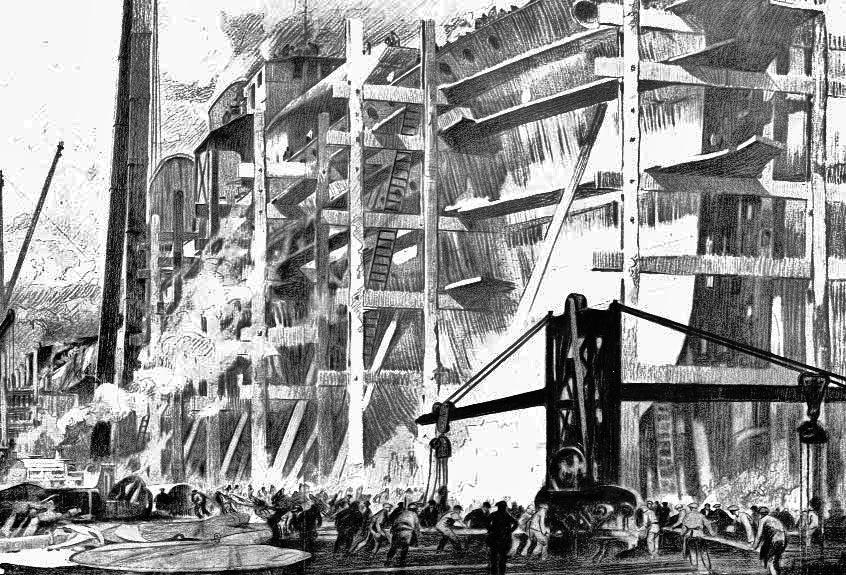Incredible pictures drawn by a popular artist of the time capture working life in a Southampton factory during the golden age of shipbuilding in the town.
The story begins in 1866 with John Isaac Thornycroft, who founded the company simply known as Thornycroft in Chiswick, London.
They went on to establish a crucial shipyard in Woolston, Southampton in 1904.
The Woolston yard became a major employer in Southampton and delivered its first ship for the Royal Navy, HMS Tartar, in 1907.
Thornycroft gained a reputation for building destroyers, a vital warship type, and the First World War saw a surge in activity with the construction of numerous warships for the British effort.
After the war, Thornycroft diversified beyond destroyers, building cargo vessels, passenger ships, tugs, and ferries.
In 1919 Thornycroft wanted to capture the workings of their factory as a social record of Southampton’s industrial era.

Distinguished artist Fred Taylor, who was known nationally for his illustrations and poster work, was commissioned in 1919 by the shipyard to capture working life in shipbuilding.
The British artist, who lived from 1875 to 1963, left his mark in the world of art through various mediums.
Born in London, Taylor honed his skills at Goldsmiths' College School of Art before furthering his studies at the Académie Julian in Paris He even travelled to Italy, fuelled by a travel scholarship he earned after winning a gold medal.
Taylor excelled in both painting and poster design.
His posters were particularly well-known, focusing on promoting architectural marvels and the travel industry, especially railway and shipping companies.
Interestingly, his artistic talents were utilised during The Second World War when he served as an official camouflage artist.

And these pictures are some of the images Taylor produced for Thornycroft.
The year of 1966 marked a turning point with the merger of Thornycroft with Vosper & Company, another prominent shipbuilding firm, to form Vosper Thornycroft Vosper Thornycroft went through further acquisitions and name changes, eventually becoming part of BAE Systems in 2008.
Today, Vospers shipyard, together with the construction berths, workshops and slipways, has all gone – a victim of a decision to move the construction of vessels away from Woolston to Portsmouth.
The Woolston yard remained operational until a new facility opened in Portsmouth Dockyard in 2003.
The vibrant hustle and bustle of workers coming and going along Victoria Road has faded into distant memory.
Decades have passed since the shipyard thrived with bustling production, sending out a variety of vessels proudly displaying the name Thornycroft on their builder's plate.
More than 85 years ago, the scene was drastically different, with ships of all shapes and sizes embarking on their journeys at sea from this powerhouse of industry.
In his artistic endeavours, Taylor skilfully depicted the fading moments of a historical construction process, using his talent to preserve intricate details of scenes that are now memories of the past.

Through these pictures we can see labourers hard at work within the foundry and boiler maker's division, as well as in the extensive machine workshop and along the slipways extending into the flowing waters of the River Itchen.
Taylor went on to become a member of the prestigious Art Workers' Guild in London from 1924 onwards and exhibited his works at various renowned institutions, including the Royal Academy, the Royal Institute, the Fine Art Society, the Ridley Art Club, and the RWA.
Fred Taylor's artistic contributions, particularly his captivating posters and architectural paintings, continue to be admired and some of his artworks are held for posterity at public galleries in Liverpool and Bristol.
His work is occasionally offered at auctions, with some pieces fetching significant prices.
His time recording Thornycroft helps strengthen the historic bond Southampton has with shipbuilding while the company's legacy lives on through the numerous vessels they built, many of which played crucial roles in maritime history.








Comments: Our rules
We want our comments to be a lively and valuable part of our community - a place where readers can debate and engage with the most important local issues. The ability to comment on our stories is a privilege, not a right, however, and that privilege may be withdrawn if it is abused or misused.
Please report any comments that break our rules.
Read the rules hereLast Updated:
Report this comment Cancel